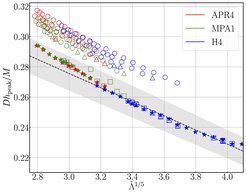Modelling 120 binary neutron star mergers
Alternative gravity simulations challenge conclusions about neutron star matter
Gravitational waves, ripples in space and time from cosmic events such as neutron star collisions, help scientists explore both gravity and the ultra-dense matter inside these stars. So far, most studies have interpreted gravitational-wave data in the context of Einstein's theory of gravity (i.e. general relativity). But what if gravity behaves differently under extreme conditions? Scientists at the Max Planck Institute for Gravitational Physics in Potsdam and the University of Kyoto have now carried out the first numerical relativity study that explicitly addresses this long-standing concern. They built the first large-scale systematic database of fully relativistic simulations under an alternative theory of gravity. By analyzing the characteristics of the resulting gravitational-wave signals, they found that effects once thought to reveal exotic nuclear physics, such as a possible phase transition inside neutron stars, could instead arise from purely gravitational physics. The new study emphasizes that to truly understand the cosmos, uncertainties in both gravitational and nuclear physics must be taken into account, as these two fields are deeply intertwined. Moreover, some of the signals the scientists have been using to probe dense matter may already be affected by uncertainties in gravity and might require more careful evaluation.

Paper abstract
We investigate how the quasiuniversal relations connecting tidal deformability with gravitational waveform characteristics and/or properties of individual neutron stars that were proposed in the literature within general relativity would be influenced in the massive Damour-Esposito-Farese-type scalar-tensor gravity. For this purpose, we systematically perform numerical relativity simulations of ∼120 binary neutron-star mergers with varying scalar coupling constants. Although only three neutron-star equations of state are adopted, a clear breach of universality can be observed in the datasets. In addition to presenting difficulties in constructing quasiuniversal relations in alternative gravity theories, we also briefly compare the impacts of non-general-relativity physics on the waveform features and those due to the first order or cross-over quantum chromodynamical phase transition.
